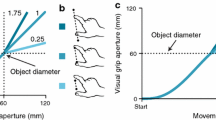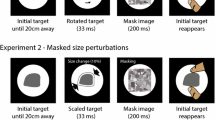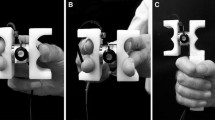Summary
-
1.
Subjects were instructed to reach and grasp cylindrical objects, using a precision grip. The objects were two concentric dowels made of translucent material placed at 35 cm from the subject. The inner (“small”) dowel was 10 cm high and 1.5 cm in diameter. The outer (“large”) dowel was 6 cm high and 6 cm in diameter. Prehension movements were monitored using a Selspot system. The displacement of a marker placed at the wrist level was used as an index for the transport of the hand at the location of the object. Markers placed at the tips of the thumb and the index finger were used for measuring the size of aperture of the finger grip.
-
2.
Kinematics of transport and grasp components were computed from the filtered displacement signals. Movement time (MT), time to peak velocity (TPV) and time to peak deceleration (TPD) of the wrist, time to peak velocity of grip aperture (TGV), time to maximum grip aperture (TGA) were the main parameters used for comparing the movements in different conditions. Spatial paths of the wrist, thumb and index markers were reconstructed in two dimensions. Variability of the spatial paths over repeated trials was computed as the surface of the ellipses defined by X and Y standard deviations from the mean path.
-
3.
Computer controlled illumination of one of the dowels was the signal for reaching toward that dowel. Blocks of trials were made to the small dowel and to the large dowel. Mean MT during blocked trials was 550 ms. The acceleration phase of the movements (measured by parameter TPV) represented 33% of MT. About half of MT (52%) was spent after TPD in a low velocity phase while the hand was approaching the object. This kinematic pattern was not influenced by whether movements were directed at small or large dowels.
-
4.
Grip aperture progressively increased during transport of the hand. TGA corresponded to about 60% of MT, that is, maximum grip aperture was reached during the low velocity phase of transport. Following TGA, fingers closed around the object until contact was made. This pattern of grip formation differed whether the movement was directed at the large or the small dowel: TGA occurred often earlier for the small dowel, and the size of the maximum grip aperture was larger for the large dowel. Variability of both the wrist and finger spatial paths was larger during the first half of MT, and tended to become very low as the hand approached the dowels.
-
5.
Selective perturbations of dowel size were randomly produced at the onset of prehension movements. Perturbations involved increase in object size (the illumination was suddenly shifted from the small to the large dowel, S-L perturbation), or decrease in object size (from the large to the small dowel, L-S perturbations). During S-L perturbations MT was increased by 175 ms on average. As TPV and TPD did not differ from control unperturbed movements, increase in MT was entirely due to lengthening of the low velocity phase following TPD.
-
6.
Grip formation was affected by the perturbation. Grip aperture first peaked to the size corresponding to the small dowel, then reincreased for accomodating the size of the large dowel. The time where grip aperture reincreased (as measured on the curve of grip velocity) occurred 329.8 ms on average after movement onset. Variability of wrist and finger spatial paths was increased with respect to controls, but it remained low during the final phase of the movement. L-S perturbations had similar effects, though attenuated with respect to S-L perturbations.
-
7.
This relatively long time taken to initiate corrections in response to object size perturbations contrasts with the short time (about 100 ms) for initiating corrections during perturbations of object position. This difference suggests some degree of independence of the mechanisms generating finger movements during grip formation from those generating transport of the hand. In addition, the kinematic coupling of the two components (demonstrated here by lengthening of the low velocity phase of the transport during correction of finger grip size) suggests the existence of a different mechanism subserving temporal coordination of the two components.
Similar content being viewed by others
References
Abbs JH, Gracco VL (1984) Control of complex motor gestures: orofacial muscle responses to load perturbations of lip during speech. J Neurophysiol 51: 705–723
Alstermark B, Gorska T, Lundberg A, Petterson LG (1990) Integration in descending motor pathways controlling the forelimb in the cat. 16. Visually guided switching of target-reaching. Exp Brain Res 80: 1–11
Arbib MA (1985) Schemas for the temporal organization of behavior. Hum Neurobiol 4: 63–72
Bizzi E, Accorneo N, Chapple W, Hogan N (1984) Posture control and trajectory formation during arm movement. J Neurosci 4: 2738–2744
Bullock D, Grossberg S (1988) Neural dynamics of planned arm movements. Emergent invariants and speed-accuracy properties during trajectory formation. Psychol Rev 95: 49–90
Cole KJ, Abbs JH (1987) Kinematic and electromyographic responses to perturbation of a rapid grasp. J Neurophysiol 57: 1498–1510
Faugier-Grimaud S, Frenois C, Stein DG (1978) Effects of posterior parietal lesions on visually guided behavior in monkeys. Neuropsychologia 16: 151–168
Franks IM, Sanderson DJ, van Donkelaar P (1990) A comparison of directly recorded and derived acceleration data in movement control research. Hum Mov Sci 9: 573–582
Gentilucci M, Castiello U, Corradini ML, Scarpa M, Umilta C, Rizzolatti G (1991) Influence of different types of grasping on the transport component of prehension movements. Neuropsychologia 29: 361–378
Georgopoulos AP, Kalaska JF, Massey JT (1981) Spatial trajectories and reaction times of aimed movements: effects of practice, uncertainty and change in target location. J Neurophysiol 46: 725–743
Goodale MA, Pélisson D, Prablanc C (1986) Large adjustments in visually guided reaching do not depend on vision of the hand or perception of target displacement. Nature 320: 748–750
Haggard P, Wing AM (1991) Remote responses to perturbation in human prehension. Neurosci Lett (in press)
Hofsten C Von, Rönnqvist L (1988) Preparation for grasping an object: a developmental study. J Exp Psychol [Hum Percept] 14: 610–621
Iberall T, Bingham G, Arbib MA (1986) Opposition space as a structuring concept for the analysis of skilled hand movements. In: Heuer H, Fromm C (eds) Generation and modulation of action pattern (Exp Brain Res Series 15). Springer, Berlin Heidelberg New York, pp 158–173
Jeannerod M, Intersegmental coordination during reaching at natural visual objects. In: Long J, Baddeley A (eds) Attention and Performance IX. Erlbaum, Hillsdale, pp 153–168
Jeannerod M (1984) The timing of natural prehension movements. J Mot Behav 16: 235–254
Jeannerod M (1986) The formation of finger grip during prehension. A cortically mediated visuomotor pattern. Behav Brain Res 19: 99–116
Jeannerod M (1990) The interaction of visual and proprioceptive cues in controlling reaching movements. In: Humphrey DR, Freund HJ (eds) Motor Control: concepts and issues. Wiley, New York, pp 277–291
Jeannerod M, Michel F, Prablanc C (1984) The control of hand movements in a case of hemianaesthesia following a parietal lesion. Brain 107: 899–920
Mac Neilage PF (1970) Motor control of serial ordering of speech. Psychol Rev 77: 182–196
Marteniuk RG, Leavitt JL, MacKenzie CL, Athenes S (1990) Functional relationships between grasp and transport components in a prehension task. Hum Mov Sci 9: 149–176
Paulignan Y, MacKenzie CL, Marteniuk R, Jeannerod M (1990) The coupling of arm and finger movements during prehension. Exp Brain Res 79: 431–436
Paulignan Y, MacKenzie CL, Marteniuk R, Jeannerod M (1991) Selective perturbation of visual input during prehension movements. I. The effects of changing object position. Exp Brain Res 83: 502–512
Pélisson D, Prablanc C, Goodale MA, Jeannerod M (1986) Visual control of reaching movements without vision of the limb. II. Evidence of fast unconscious processes correcting the trajectory of the hand to the final position of a double-step stimulus. Exp Brain Res 62: 303–311
Perenin MT, Vighetto A (1988) Optic ataxia: a specific disruption in visuomotor mechanisms. I. Different aspects of the deficit in reaching for objects. Brain 111: 643–674
Prablanc C, Echallier JF, Jeannerod M, Komilis E (1979) Optimal response of eye and hand motor systems in pointing at a visual target. II. Static and dynamic visual cues in the control of hand movement. Biol Cybern 35: 183–187
Soechting JF, Lacquaniti F (1983) Modification of trajectory of a pointing movement in response to a change in target location. J Neurophysiol 49: 548–564
Taira M, Mine S, Georgopoulos AP, Murata A, Sakata H (1990) Parietal cortex neurons of the monkey related to the visual guidance of hand movements. Exp Brain Res 83: 29–36
Viviani P, Terzuolo C (1980) Space-time invariance in learned motor skills. In: Stelmach GE, Requin J (eds) Tutorials in motor behavior. North-Holland, Amsterdam, pp 525–533
Wallace SA, Weeks DL (1988) Temporal constraints in the control of prehensive movements. J Mot Behav 20: 81–105
Wing AM, Fraser C (1983) The contribution of the thumb to reaching movements. Q J Exp Psychol 35A: 297–309
Wing AM, Turton A, Fraser C (1986) Grasp size and accuracy of approach in reaching. J Mot Behav 18: 245–260
Author information
Authors and Affiliations
Additional information
Supported by INSERM, Paris
Rights and permissions
About this article
Cite this article
Paulignan, Y., Jeannerod, M., MacKenzie, C. et al. Selective perturbation of visual input during prehension movements. Exp Brain Res 87, 407–420 (1991). https://doi.org/10.1007/BF00231858
Received:
Accepted:
Issue Date:
DOI: https://doi.org/10.1007/BF00231858




